

National Economy and Chief Industries of the UK
Дипломдар мен сертификаттарды алып үлгеріңіз!



1 слайд
Theme: National Economy and Chief
Industries of the UK.
1 слайд
Theme: National Economy and Chief Industries of the UK.

2 слайд
Plan:
1 •
Economy
2 •
Industrial Revolution
3 •
The years of self-confidence
4 •
Changes in the life of people
2 слайд
Plan: 1 • Economy 2 • Industrial Revolution 3 • The years of self-confidence 4 • Changes in the life of people
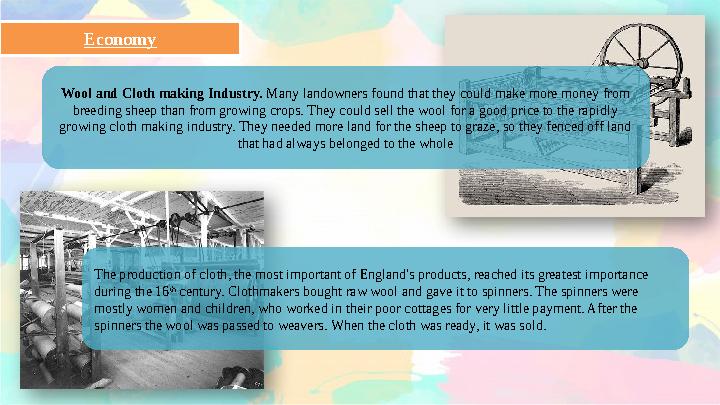
3 слайд
Economy
Wool and Cloth making Industry. Many landown ers found that they could make more money from
breeding sheep than from growing crops. They could sell the wool for a good price to the rapidly
growing cloth making industry. They needed more land for the sheep to graze, so they fenced off land
that had always belonged to the whole
The production of cloth, the most important of England's products, reached its greatest importance
during the 16 th
century. Clothmakers bought raw wool and gave it to spinners. The spinners were
mostly women and children, who worked in their poor cot
tages for very little payment. After the
spinners the wool was passed to weavers. When the cloth was ready, it was sold.
3 слайд
Economy Wool and Cloth making Industry. Many landown ers found that they could make more money from breeding sheep than from growing crops. They could sell the wool for a good price to the rapidly growing cloth making industry. They needed more land for the sheep to graze, so they fenced off land that had always belonged to the whole The production of cloth, the most important of England's products, reached its greatest importance during the 16 th century. Clothmakers bought raw wool and gave it to spinners. The spinners were mostly women and children, who worked in their poor cot tages for very little payment. After the spinners the wool was passed to weavers. When the cloth was ready, it was sold.

4 слайд
Coal and Steel. In the 16 th
century people learned to burn coal in stoves instead
of wood. Coal gave greater heat when burning. By using coal instead of wood
fires, people were able to produce greatly im proved steel.
Improved steel was used to make knives and forks, clocks, watches, nails and
pins. Birming
ham, by using coal fires to make steel, grew in the 16 th
century
from a village into an important industrial city.
4 слайд
Coal and Steel. In the 16 th century people learned to burn coal in stoves instead of wood. Coal gave greater heat when burning. By using coal instead of wood fires, people were able to produce greatly im proved steel. Improved steel was used to make knives and forks, clocks, watches, nails and pins. Birming ham, by using coal fires to make steel, grew in the 16 th century from a village into an important industrial city.
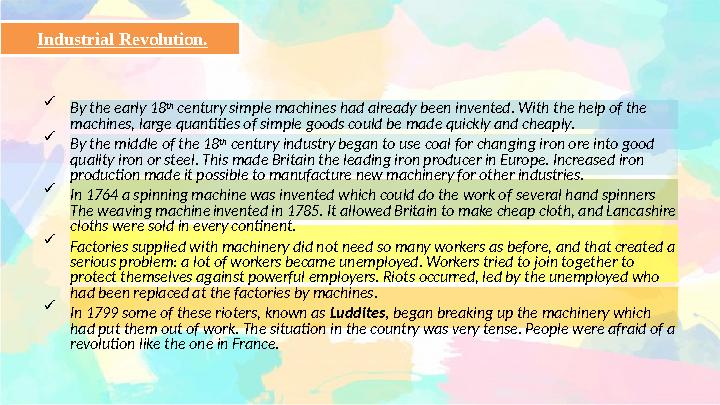
5 слайд
Industrial Revolution.
By the early 18 th
century simple machines had al ready been invented. With the help of the
machines, large quantities of simple goods could be made quickly and cheaply.
By the middle of the 18 th
century industry began to use coal for changing iron ore into good
quality iron or steel. This made Britain the leading iron producer in Europe. Increased iron
production made it possible to manufacture new machinery for other industries.
In 1764 a spinning machine was invented which could do the work of several hand spinners
The weaving machine
invented in 1785. It al
lowed Britain to make cheap cloth, and Lanca shire
cloths were sold in every continent.
Factories supplied with machinery did not need so many workers as before, and that created a
serious problem: a lot of workers became unemployed. Workers tried to join together to
protect themselves against powerful employers. Riots occurred, led by the unemployed who
had been replaced at the factories by machines.
In 1799 some of these rioters, known as Luddites, began breaking up the machinery which
had put them out of work. The situation in the country was very tense. People were afraid of a
revolution like the one in France.
5 слайд
Industrial Revolution. By the early 18 th century simple machines had al ready been invented. With the help of the machines, large quantities of simple goods could be made quickly and cheaply. By the middle of the 18 th century industry began to use coal for changing iron ore into good quality iron or steel. This made Britain the leading iron producer in Europe. Increased iron production made it possible to manufacture new machinery for other industries. In 1764 a spinning machine was invented which could do the work of several hand spinners The weaving machine invented in 1785. It al lowed Britain to make cheap cloth, and Lanca shire cloths were sold in every continent. Factories supplied with machinery did not need so many workers as before, and that created a serious problem: a lot of workers became unemployed. Workers tried to join together to protect themselves against powerful employers. Riots occurred, led by the unemployed who had been replaced at the factories by machines. In 1799 some of these rioters, known as Luddites, began breaking up the machinery which had put them out of work. The situation in the country was very tense. People were afraid of a revolution like the one in France.
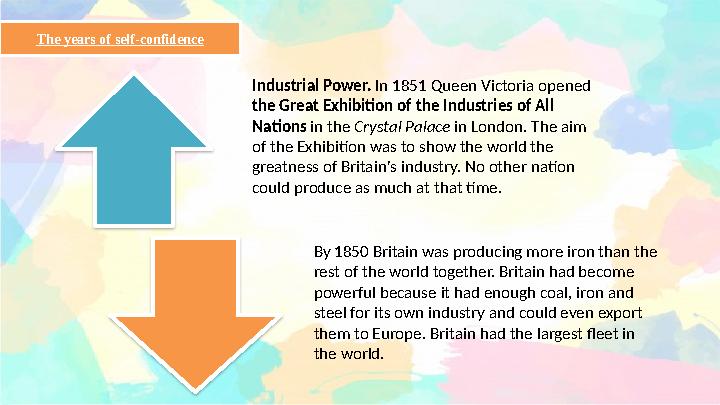
6 слайд
The years of self-confidence
Industrial Power. In 1851 Queen Victoria opened
the Great Exhibi tion of the Industries of All
Nations in the Crystal Palace in London. The aim
of the Exhibition was to show the world the
greatness of Britain's industry. No other nation
could produce as much at that time.
By 1850 Britain was producing more iron than the
rest of the world together. Britain had become
powerful because it had enough coal, iron and
steel for its own industry and could even export
them to Europe. Britain had the largest fleet in
the world.
6 слайд
The years of self-confidence Industrial Power. In 1851 Queen Victoria opened the Great Exhibi tion of the Industries of All Nations in the Crystal Palace in London. The aim of the Exhibition was to show the world the greatness of Britain's industry. No other nation could produce as much at that time. By 1850 Britain was producing more iron than the rest of the world together. Britain had become powerful because it had enough coal, iron and steel for its own industry and could even export them to Europe. Britain had the largest fleet in the world.
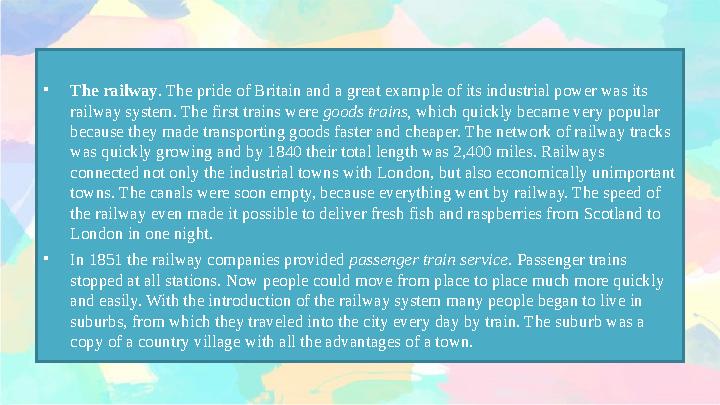
7 слайд
•
The railway . The pride of Britain and a great exam ple of its industrial power was its
railway system. The first trains were goods trains, which quickly became very popular
because they made transporting goods faster and cheaper. The network of railway tracks
was quickly growing and by 1840 their total length was 2,400 miles. Railways
connected not only the indus
trial towns with London, but also economically unimportant
towns. The canals were soon empty, because everything went by railway. The speed of
the railway even made it possible to deliver fresh fish and raspberries from Scotland to
London in one night.
•
In 1851 the railway companies provided passenger train service. Passenger trains
stopped at all stations. Now people could move from place to place much more quickly
and easily. With the introduction of the railway system many people began to live in
suburbs, from which they traveled into the city every day by train. The sub
urb was a
copy of a country village with all the advantages of a town.
7 слайд
• The railway . The pride of Britain and a great exam ple of its industrial power was its railway system. The first trains were goods trains, which quickly became very popular because they made transporting goods faster and cheaper. The network of railway tracks was quickly growing and by 1840 their total length was 2,400 miles. Railways connected not only the indus trial towns with London, but also economically unimportant towns. The canals were soon empty, because everything went by railway. The speed of the railway even made it possible to deliver fresh fish and raspberries from Scotland to London in one night. • In 1851 the railway companies provided passenger train service. Passenger trains stopped at all stations. Now people could move from place to place much more quickly and easily. With the introduction of the railway system many people began to live in suburbs, from which they traveled into the city every day by train. The sub urb was a copy of a country village with all the advantages of a town.
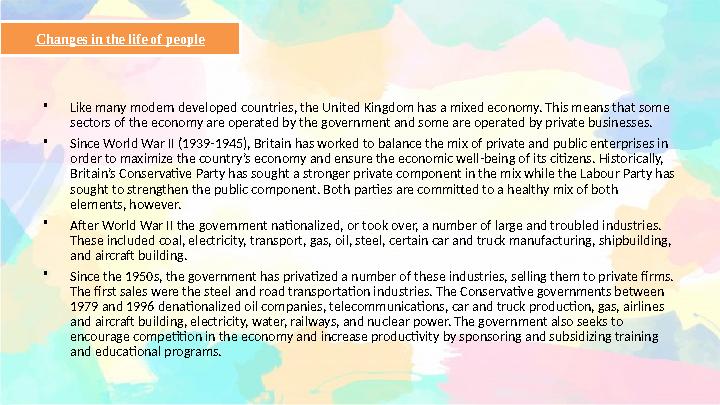
8 слайд
•
Like many modern developed countries, the United Kingdom has a mixed economy. This means that some
sectors of the economy are operated by the government and some are operated by private businesses.
•
Since World War II (1939-1945), Britain has worked to balance the mix of private and public enterprises in
order to maximize the country’s economy and ensure the economic well-being of its citizens. Historically,
Britain’s Conservative Party has sought a stronger private component in the mix while the Labour Party has
sought to strengthen the public component. Both parties are committed to a healthy mix of both
elements, however.
•
After World War II the government nationalized, or took over, a number of large and troubled industries.
These included coal, electricity, transport, gas, oil, steel, certain car and truck manufacturing, shipbuilding,
and aircraft building.
•
Since the 1950s, the government has privatized a number of these industries, selling them to private firms.
The first sales were the steel and road transportation industries. The Conservative governments between
1979 and 1996 denationalized oil companies, telecommunications, car and truck production, gas, airlines
and aircraft building, electricity, water, railways, and nuclear power. The government also seeks to
encourage competition in the economy and increase productivity by sponsoring and subsidizing training
and educational programs. Changes in the life of people
8 слайд
• Like many modern developed countries, the United Kingdom has a mixed economy. This means that some sectors of the economy are operated by the government and some are operated by private businesses. • Since World War II (1939-1945), Britain has worked to balance the mix of private and public enterprises in order to maximize the country’s economy and ensure the economic well-being of its citizens. Historically, Britain’s Conservative Party has sought a stronger private component in the mix while the Labour Party has sought to strengthen the public component. Both parties are committed to a healthy mix of both elements, however. • After World War II the government nationalized, or took over, a number of large and troubled industries. These included coal, electricity, transport, gas, oil, steel, certain car and truck manufacturing, shipbuilding, and aircraft building. • Since the 1950s, the government has privatized a number of these industries, selling them to private firms. The first sales were the steel and road transportation industries. The Conservative governments between 1979 and 1996 denationalized oil companies, telecommunications, car and truck production, gas, airlines and aircraft building, electricity, water, railways, and nuclear power. The government also seeks to encourage competition in the economy and increase productivity by sponsoring and subsidizing training and educational programs. Changes in the life of people



